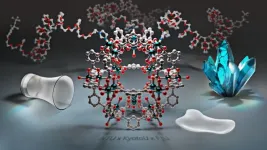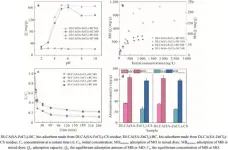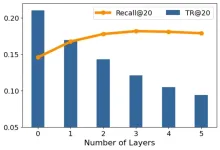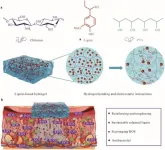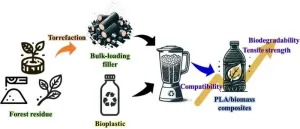(Press-News.org) Embargoed until 4:00 a.m. CT/5:00 a.m. ET Wed., Nov. 13, 2024
DALLAS, Nov. 13, 2024 — Advances in cardiac imaging techniques and risk categorization have led to improvements in diagnosis, initial treatment and long-term management of patients with Kawasaki Disease, according to a new scientific statement published today in the American Heart Association’s flagship, peer-reviewed journal Circulation.
The new statement, “Update on Diagnosis and Management of Kawasaki Disease,” summarizes the data published since the 2017 American Heart Association Scientific Statement on Kawasaki Disease related to diagnostic criteria, risk scores and treatment options for children and adults with this condition.
Statement highlights include:
Kawasaki Disease is a rare but serious illness primarily affecting children younger than five years old. The disease can cause inflamed blood vessels throughout the body, and it is the leading cause of acquired (not congenital) heart disease in children throughout the developed world.
Although the cause of Kawasaki Disease is still unknown, however, there is a strong suspicion that the cause is infectious but no single infectious agent has been implicated. Health care professionals diagnose Kawasaki Disease based on a set of well-established symptoms, including prolonged fever, rash, reddened eyes and swelling of the hands and feet. Without timely treatment, one in four children can develop coronary artery dilation and/or coronary artery aneurysms.
Health care professionals use coronary artery Z-scores, a measurement that compares the coronary artery diameter of a child with Kawasaki Disease to the expected diameter of coronary arteries in healthy children of similar age, sex and body size to evaluate coronary abnormalities and classify risk. Children with Z-scores greater than 2.5 are at increased risk for developing coronary artery aneurysms. Although a Z-score alone should not determine the damage to coronary arteries, the statement highlights the need for consistent Z-score equation over time to ensure a patient’s risk classification does not change.
Early identification of children with Kawasaki Disease at risk of developing coronary artery aneurysms remains a challenge in a multiethnic population and it is critical to diagnose Kawasaki Disease early for optimal management. A new risk scoring system specific to children in North America combines factors like age younger than six months, Asian race, elevated coronary artery Z-scores of at least 2 and higher C-reactive protein levels (a substance in the blood that is elevated when there’s inflammation in the body). These advancements help clinicians identify high-risk patients who might require more intensive initial treatment to potentially reduce coronary artery complications.
The statement suggests echocardiograms at regular time intervals, with a higher frequency in patients with coronary artery Z-scores greater than 2.5, to track the progression of any coronary artery abnormalities during hospitalization or after discharge. Echocardiographic, or heart ultrasound, techniques have improved since 2017 to better detect coronary artery dilation or aneurysms, which can help patients avoid more serious and/or long-term heart problems.
Intravenous immunoglobulin (IVIG), a mixture of antibodies and proteins to help fight infections, remains the standard of care for patients with Kawasaki Disease. Studies have shown, however, that dosing adjustments based on lean body mass in patients with obesity can help reduce the risks of complications.
The statement reevaluates the use of aspirin during the acute phase of Kawasaki Disease. Recent studies have shown using low- or medium-dose aspirin may be just as effective as high-dose aspirin. Ongoing trials are comparing different doses to confirm these results.
Recent studies have found adding other therapies, such as corticosteroids or infliximab, can help children with Kawasaki Disease who are at high risk for IVIG resistance. These new options may be effective in preventing coronary artery complications and offer health care professionals more options in managing treatment-resistant cases.
For children with Kawasaki Disease who have larger coronary aneurysms, blood-thinning medications like aspirin (typically 81 mg daily) combined with anticoagulants, such as warfarin or low molecular weight heparin, may help prevent dangerous blood clots. Recent evidence indicates that using direct oral anticoagulants in the treatment of patients with large coronary artery aneurysms may be more effective and safer, require less monitoring and have fewer side effects, however, further research is needed to confirm these findings.
The outbreak of COVID-19 saw an increase in a related condition called Multisystem Inflammatory Syndrome in Children (MIS-C). MIS-C became a diagnostic challenge since many symptoms including fever, rash and heart-related issues, overlap with symptoms of Kawasaki Disease. New data have helped differentiate the two conditions by identifying additional symptoms of MIS-C that include gastrointestinal issues, a low number of platelets that could cause bruising or bleeding, and a lower than normal number of white blood cells. In contrast, coronary artery involvement remains a hallmark of Kawasaki Disease, helping health care professionals make more accurate diagnoses. Machine learning algorithms have also been developed that may help clinicians distinguish between Kawasaki Disease and MIS-C.
All medical centers with patients with Kawasaki Disease and giant coronary artery aneurysms need to have a multidisciplinary heart team and a protocol in place to address major adverse cardiac events.
This updated scientific statement highlights the need for a formal transition program to ensure continuity of care for adolescents and adults with a history of Kawasaki Disease. Patients with giant aneurysms remain at high risk for heart attack and require lifelong monitoring and care. Further research is needed to optimize the timing and methods used to monitor long-term heart health in patients with the disease.
Individuals with Kawasaki Disease who plan on becoming pregnant are at high risk for adverse cardiac events and require care from obstetricians who have knowledge of Kawasaki Disease in tandem with consultations with a cardiologist.
This scientific statement was prepared by the volunteer writing group on behalf of the American Heart Association’s Rheumatic Feber, Endocarditis, and Kawasaki Disease Committee of the Council on Lifelong Congenital Heart Disease and Heart Health in the Youn; the Council on Cardiovascular and Stroke Nursing; the Council on Cardiovascular Radiology and Intervention; and the Council on Clinical Cardiology. American Heart Association scientific statements promote greater awareness about cardiovascular diseases and stroke issues and help facilitate informed health care decisions. Scientific statements outline what is currently known about a topic and what areas need additional research. While scientific statements inform the development of guidelines, they do not make treatment recommendations. American Heart Association guidelines provide the Association’s official clinical practice recommendations.
Statement writing group authors and their disclosures are listed in the manuscript.
The Association receives funding primarily from individuals. Foundations and corporations (including pharmaceutical, device manufacturers and other companies) also make donations and fund specific Association programs and events. The Association has strict policies to prevent these relationships from influencing the science content. Revenues from pharmaceutical and biotech companies, device manufacturers and health insurance providers, and the Association’s overall financial information are available here.
Additional Resources:
Available multimedia is on right column of release link.
After Nov. 13, 2024, view the manuscript online.
AHA News Release: Heart issues after COVID-19 uncommon in children & young adults, more research needed (April 2022)
AHA News Release: UPDATED: Heart function recovered quickly in children with COVID-19-related MIS-C condition (Jan. 2022)
AHA News Release: Formal plans needed to support teens with Kawasaki disease in transition to adult care (Oct. 2021)
Follow AHA/ASA news on X @HeartNews
Follow news from the AHA’s flagship journal Circulation @CircAHA
###
About the American Heart Association
The American Heart Association is a relentless force for a world of longer, healthier lives. We are dedicated to ensuring equitable health in all communities. Through collaboration with numerous organizations, and powered by millions of volunteers, we fund innovative research, advocate for the public’s health and share lifesaving resources. The Dallas-based organization has been a leading source of health information for a century. During 2024 - our Centennial year - we celebrate our rich 100-year history and accomplishments. As we forge ahead into our second century of bold discovery and impact, our vision is to advance health and hope for everyone, everywhere. Connect with us on heart.org, Facebook, X or by calling 1-800-AHA-USA1.
END
Early detection, intensive treatment critical for high-risk patients with Kawasaki Disease
A new scientific statement from the American Heart Association highlights new clinical data related to diagnosis, risk classification and treatment, emphasizing the need for tailored management strategies
2024-11-13
ELSE PRESS RELEASES FROM THIS DATE:
A phase-transformable membrane for efficient gas separation could revolutionize industrial applications
2024-11-13
Industrial gas separation, essential for clean energy and environmental protection, demands efficiency and adaptability. Current materials, however, lack the flexibility to selectively separate gases like carbon dioxide (CO₂) and hydrogen (H₂) while remaining energy-efficient. Researchers at the Institute for Integrated Cell-Material Sciences (WPI-iCeMS) at Kyoto University and the Department of Chemical Engineering at National Taiwan University have developed a phase-transformable membrane that could meet these needs.
This innovative membrane design relies on a unique combination of metal-organic polyhedra (MOP) with polyethylene glycol (PEG) chains. “Traditional ...
From camera to lab: Dr. Etienne Sibille transforms brain aging and depression research
2024-11-13
Toronto, Canada, November 13, 2024 - In science, the most fascinating breakthroughs often come from unexpected places. For Dr. Etienne Sibille, professor at the University of Toronto, and director of the Neurobiology of Depression and Aging program at CAMH, and co-founder and Chief Scientific Officer of Damona Pharmaceuticals, the path to revolutionizing mental health treatment began not in a laboratory, but through a camera lens in New York City.
"I grew up in France and went to medical school, but it was not for me. I was too restless and moved to ...
Depression rates in LGBTQIA+ students are three times higher than their peers, new research suggests
2024-11-13
The findings, which were published in the Journal of American College Health, uncover an alarming rise in depression rates among all higher education students in the United States, but especially among sexual and gender minorities. This population includes those who identified as lesbian, gay, bisexual, transgender, queer, questioning, intersex, asexual (LGBTQIA+), non-binary or gender non-conforming, and other identities.
“This study highlights the critical need for targeted interventions to support the mental health and well-being ...
Most parents don’t ask about firearms in the homes their kids visit
2024-11-13
Over 60 percent of Illinois parents had never asked another parent about an unlocked firearm in their home before allowing their child to visit for a playdate, according to a survey from Ann & Robert H. Lurie Children’s Hospital of Chicago published in Pediatrics. Many parents reported they had not asked about firearms because it never occurred to them to do so, which highlights a critical need to raise awareness of this important safety concern.
Among children 0-14 years old, almost 20 percent of unintentional firearm-related deaths occur at a friend’s home. ...
Beer-only drinkers’ diets are worse than wine drinkers
2024-11-13
SAN DIEGO, California (Nov. 13, 2024) — Beer drinkers have lower-quality diets, are less active, and are more likely to smoke cigarettes than people who drink wine, liquor, or a combination, according to a study scheduled for presentation at The Liver Meeting, held by the American Association for the Study of Liver Diseases.
“Alcohol overuse is the leading cause of cirrhosis in the U.S., and metabolic dysfunction-associated steatotic liver disease (MASLD) is rapidly increasing,” said Madeline Novack, chief resident at Tulane School of Medicine’s internal medicine residency program and lead author of the study. “Both ...
Eco-friendly biomass pretreatment method yields efficient biofuels and adsorbents
2024-11-13
As global demand for sustainable energy solutions increases, bioethanol production from lignocellulosic biomass is gaining traction. However, traditional methods face limitations due to high processing costs and waste issues. A recent study led by Xinchuan Yuan, published in the Journal of Bioresources and Bioproducts, presents an innovative biomass pretreatment method that not only improves bioethanol production efficiency but also utilizes biomass residues as bio-adsorbents for wastewater treatment, potentially transforming the industry.
Producing ...
How graph convolutions amplify popularity bias for recommendation?
2024-11-13
Graph convolutional networks (GCNs) have become prevalent in recommender system (RS) due to their superiority in modeling collaborative patterns. Although improving the overall accuracy, GCNs unfortunately amplify popularity bias --- tail items are less likely to be recommended. This effect prevents the GCN-based RS from making precise and fair recommendations, decreasing the effectiveness of recommender systems in the long run.
Performance change of LightGCN with different graph convolution layers on Gowalla. Recall@20 and TR@20 ...
New lignin-based hydrogel breakthrough for wound healing and controlled drug release
2024-11-13
As the demand for advanced wound healing and drug delivery materials grows, scientists are turning to sustainable, bioactive materials for innovative solutions. A recent study by Bowei Wang et al., published in the Journal of Bioresources and Bioproducts, presents a breakthrough in lignin-based hydrogels designed to combine mechanical strength with bioactivity. This research reveals a controlled-release polyvinyl alcohol (PVA) and chitosan (CS) hydrogel, augmented with sulfonated lignin, which could revolutionize the treatment of complex wounds and enable sustained drug ...
Enhancing compatibility and biodegradability of PLA/biomass composites via forest residue torrefaction
2024-11-13
With an increasing focus on environmental sustainability, researchers are seeking ways to improve the biodegradability and mechanical properties of bioplastics, particularly polylactic acid (PLA). A recent study by June-Ho Choi and colleagues, published in the Journal of Bioresources and Bioproducts, presents a promising approach that enhances the compatibility and decomposition of PLA when combined with biomass through a process called torrefaction. This innovation offers practical improvements for sustainable material applications, positioning PLA as a viable, eco-friendly alternative in various industries.
PLA, ...
Time alone heightens ‘threat alert’ in teenagers – even when connecting on social media
2024-11-13
Scientists detect a heightened “threat vigilance” reaction in adolescents after a few hours of isolation, which socialising online doesn’t appear to ameliorate.
They say the findings might shed light on the link between loneliness and mental health conditions such as anxiety disorders, which are on the rise in young people.
Experiment is the first to find an increased threat response triggered by isolation in humans (previous studies have found the effect in animals such as mice).
People ...
LAST 30 PRESS RELEASES:
Orthopedics can play critical role in identifying intimate partner violence
Worms as particle sweepers
Second spider-parasitic mite described in Brazil
January 2026 issues of APA journals feature new research on autism, pediatric anxiety, psychedelic therapy, suicide prevention and more
Private equity acquired more than 500 autism centers over the past decade, new study shows
New cervical cancer screening guidelines from the US Department of Health and Human Services
Estimated burden of COVID-19 illnesses, medical visits, hospitalizations, and deaths in the US from October 2022 to September 2024
Smartphone use during school hours by US youth
Food insecurity and adverse social conditions tied to increased risk of long COVID in children
Earliest, hottest galaxy cluster gas on record could change our cosmological models
Greenland’s Prudhoe Dome ice cap was completely gone only 7,000 years ago, first GreenDrill study finds
Scientific validity of blue zones longevity research confirmed
Injectable breast ‘implant’ offers alternative to traditional surgeries
Neuroscientists devise formulas to measure multilingualism
New prostate cancer trial seeks to reduce toxicity without sacrificing efficacy
Geometry shapes life
A CRISPR screen reveals many previously unrecognized genes required for brain development and a new neurodevelopmental disorder
Hot flush treatment has anti-breast cancer activity, study finds
Securing AI systems against growing cybersecurity threats
Longest observation of an active solar region
Why nail-biting, procrastination and other self-sabotaging behaviors are rooted in survival instincts
Regional variations in mechanical properties of porcine leptomeninges
Artificial empathy in therapy and healthcare: advancements in interpersonal interaction technologies
Why some brains switch gears more efficiently than others
UVA’s Jundong Li wins ICDM’S 2025 Tao Li Award for data mining, machine learning
UVA’s low-power, high-performance computer power player Mircea Stan earns National Academy of Inventors fellowship
Not playing by the rules: USU researcher explores filamentous algae dynamics in rivers
Do our body clocks influence our risk of dementia?
Anthropologists offer new evidence of bipedalism in long-debated fossil discovery
Safer receipt paper from wood
[Press-News.org] Early detection, intensive treatment critical for high-risk patients with Kawasaki DiseaseA new scientific statement from the American Heart Association highlights new clinical data related to diagnosis, risk classification and treatment, emphasizing the need for tailored management strategies
